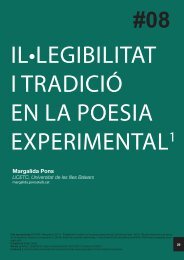03 - 452ºF
03 - 452ºF
03 - 452ºF
You also want an ePaper? Increase the reach of your titles
YUMPU automatically turns print PDFs into web optimized ePapers that Google loves.
Therefore, when the viewer witnesses Marge Simpson portraying the<br />
figure of Lady Macbeth, a plethora of conflicting but contemporaneous<br />
reactions occur. We can count both of these fictional ladies as liminal,<br />
but see that they are constrained by ideas of gender from different<br />
time periods. However, we can also understand that there is still<br />
something «evil» about a woman attempting to control her husband,<br />
especially for the sake of ambition. And, if Marge (as Lady Macbeth)<br />
is also portrayed as a witch, then the impact of gender on the modern<br />
construction of the witch is still as essential as it was in the Early<br />
Modern construction.<br />
I would like to end by returning to Lisa’s question posed at the<br />
beginning of this project: Why is it that when a woman is confident and<br />
powerful, they call her a witch? As seen in this discussion, there are<br />
many proposed answers to this question in regards to how the witch<br />
was constructed for the Early Modern period. These theories range<br />
from socio-economic status to anxieties concerning motherhood<br />
and from gender role expectations to notions of identity and agency.<br />
What an analysis of the witch in The Simpsons has shown is that<br />
those very issues still construct the figure of the witch in modern<br />
popular culture, because much of how the witch is defined is closely<br />
related to how we define «woman».<br />
The Simpsons, Gender Roles, and Witchcraft: The Witch in Modern Popular Culture - Sarah Antinora<br />
<strong>452ºF</strong>. #<strong>03</strong> (2010) 115-131.<br />
129










